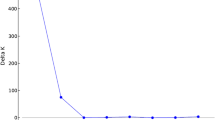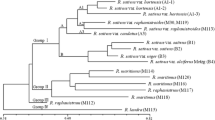Abstract
Genetic variation between samples of Oryza sativa from 19 localities in Bangladesh and Bhutan was assessed using two PCR-based molecular marker systems: RAPD (random amplification of polymorphic DNA) and ISSR-PCR (inter-simple sequence repeat polymerase chain reaction). Employing RAPD, a set of 14 decanucleotides of arbitrary sequence directed the amplification of 94 reproducible marker bands, 47 (50%) of which were polymorphic. In addition, a set of 9 ISSR primers were used to direct amplification of 71 PCR products, 40 (56%) of which were polymorphic. Multivariate analyses of the two PCR-based molecular marker data sets provided evidence that the patterns of variation correspond with the classification described by Glaszmann [9] using isozyme analysis. Subtle differences in the relationships revealed between rice groups using the two types of PCR-based marker led to investigations of their map positions using an intraspecific doubled haploid mapping population. The observation that the chromosomal locations of markers can influence diversity assessments is presented and the significance of this is discussed.
Similar content being viewed by others
References
Arumuganathan K, Earle ED: Nuclear DNA content of some important plant species. Plant Mol Biol Rep 9: 208–218 (1995).
Caetano-Anollés G: DNA fingerprinting: MAAP: a versatile and universal tool for genome analysis. Plant Mol Biol 25: 1011–1026 (1994).
Causse MA, Fulton TM, Cho YG, Ahn SN, Chunwongse J, Wu K, Xiao J, Yu Z, Ronald PC, Harrington SE, Second G, McCouch SR, Tanksley SD: Saturated molecular map of the rice genome based on an interspecific backcross population. Genetics 138: 1251–1274 (1994).
Chang TT: The origin, evolution, cultivation, dissemination, and diversification of Asian and African rices. Euphytica 25: 425–441 (1976).
Charters YM, Robertson A, Wilkinson MJ, Ramsay G: PCR analysis of oilseed rape cultivars (Brassica oleracea L. ssp. oleifera) using 5′-anchored simple sequence repeat (SSR) primers. Theor Appl Genet 92: 442–447 (1996).
Francisco-Ortega J, Newbury HJ, Ford-Lloyd BV: Numerical analyses of RAPD data highlight the origin of cultivated tagasaste (Chamaecytisus proliferus ssp. palmensis in the Canary Islands. Theor Appl Genet 87: 264–270 (1993).
Fukuoka S, Hosaka K, Kamijima O: Use of random amplified polymorphic DNAs (RAPDs) for identification of rice accessions. Jpn J Genet 67: 243–352 (1992).
Gawel NJ, Jarret RL: A modified CTAB DNA extraction procedure for Musa and Ipomoea. Plant Mol Biol Rep 9: 262–266 (1991).
Glaszmann JC: Isozymes and classification of Asian rice varieties. Theor Appl Genet 74: 21–30 (1987).
Glaszmann JC: Geographic pattern of variation among Asian native cultivars (Oryza Savita L.) based on fifteen isozyme loci. Genome 30: 782–792 (1988).
Grady DL, Ratliff RL, Robinson DL, McCanlies EC, Meyne J, Moyzis RK: Highly conserved repetitive DNA sequences are present at human centromeres. Proc Natl Acad Sci USA 89: 1695–1699 (1992).
Gupta M, Chyi Y.-S., Romero-Severson, Owen JL: Amplification of DNA markers from evolutionarily diverse genomes using single primers of simple-sequence repeats. Theor Appl Genet 89, 998–1006 (1994).
Hill MO: TWINSPAN — a Fortran program for arranging multivariate data in an ordered two-way table by classification of the individuals and attributes. Cornell University, Ithaca, NY (1979).
Huang N, McCouch S, Mew T, Parco A, Guiderdoni E: Development of an RFLP map from a doubled haploid population in rice. Rice Genet Newsl 11: 134–137 (1994).
Kantety RV, Zeng X, Bennetzen JL, Zehr B: Assessment of genetic diversity in dent and popcorn (Zea mays L.) inbred lines using inter-simple sequence repeat (ISSR) amplification. Mol Breed 1: 365–373 (1995).
Kosambi DD: The estimation of map distances from recombination values. Ann Eugenet 12: 172–175 (1944).
Kurata N, Nagamura Y, Yamamoto K, Harushima Y, Sue N, Wu J, Antonio BA, Shomura A, Shimizu T, Lin SY, Inoue T, Fukuda A, Shimano T, Kuboki Y, Toyama T, Miyamoto Y, Kirihaya T, Hayasaka K, Miyao A, Monna L, Zhong HS, Tamura Y, Wang ZX, Momma T, Umehara Y, Yano M, Sasaki T, Minobe Y: A 300 kilobase interval genetic map of rice including 883 expressed sequences. Nature Genet 8: 365–372 (1994).
Lander ES, Green P, Abrahamson J, Barlow A, Daly MJ, Lincoln SE, Newburg L: MAPMAKER: An interactive computer package for constructing primary genetic linkage maps of experimental and natural populations. Genomics 1: 174–81 (1987).
Litt M, Luty J: Hypervariablemicrosatellite revealed by in vitro amplification of a dinucleotide repeat within cardiac muscle actin gene. Am J Hun Genet 44: 397–401 (1989).
Mackill DJ: Plant genetic resources: classifying japonica rice cultivars with RAPD markers. Crop Sci 35: 889–894 (1995).
Ramakishana W, Lagu MD, Gupta VS, Ranjekar PK: DNA fingerprinting in rice using oligonucleotide probes specific for simple sequence repetitive DNA sequences. Theor Appl Genet 88: 402–406 (1994).
Rohlf FJ: NTSYS-pc Numerical Taxonomy and Multivariate Analysis System Version 1.70. State University of New York, Stony Brook, NY (1992).
Saiki RK, Scharf S, Faloona F, Mullis KB, Horn GT, Erlich HA, Arnheim N: Enzymatic amplification of beta-globin genomic sequences and restriction site analysis for diagnosis of sickle cell anemia. Science 230: 1350–1354 (1985).
Salimath SS, de Oliveira AC, Godwin ID, Bennetzen JL: Assessment of genome origins and genetic diversity in the genus Eleusine with DNA markers. Genome 38: 757–763 (1995).
Sambrook J, Fritsch EF, Maniatis T: Molecular Cloning: A Laboratory Manual, 2nd ed. Cold Spring Harbour Laboratory Press, Cold-Spring Harbor, NY (1989).
Singh K, Ishii T, Parco A, Huang N, Brar DS, Khush GS: Centromere mapping and orientation of the molecular linkage map of rice (Oryza sativa L.) Proc Natl Acad Sci USA 93: 6163–6268 (1995).
Tautz R: Hypervariability of simple sequences as a general source for polymorphic DNA markers. Nucl Acids Res 17: 6463–6471 (1989).
Tsumara Y, Ohba K, Strauss SH: Diversity and inheritance of inter-simple sequence repeat polymorphisms in Douglas fir (Pseudotsuga menziessi) and sugi (Cryptomeria japonica). Theor Appl Genet 92: 40–45 (1996).
Virk PS, Ford-Lloyd BV, Jackson MT, Newbury HJ: Use of RAPD for the study of diversity within plant germplasm collections. Heredity 74: 170–179 (1995).
Virk PS, Newbury HJ, Jackson MT, Ford-Lloyd BV: The identification of duplicate accessions within a rice germplasm collection using RAPD analysis. Theor Appl Genet 90: 1049–1055 (1995).
Wang ZY, Tanksley SD: Restriction fragment length polymorphism in Oryza sativa L. Genome 32: 1113–1118 (1989).
Wang G, Castiglione S, Zhang J, Fu R, Ma J, Li W, Sun Y, Sala F: Hybrid rice Oryza sativa L.: identification and parentage determination by RAPD fingerprinting. Plant Cell Rep 14: 112–115 (1994).
Weber JL, May PE: Abundant class of human DNA polymorphisms which can be typed using the polymerase chain reaction. Am J Hum Genet 44: 388–396 (1989).
Welsh J, McClelland M: Fingerprinting genomes using PCR with arbitrary primers. Nucl Acids Res 18: 7213–7218 (1990).
Williams JGK, Kubelik AR, Livak KJ, Rafalski JA, Tingey SV: DNA polymorphisms amplified by arbitrary primers are useful as genetic markers. Nucl Acids Res 18: 6531–6535 (1990).
Wu K, Tanksley SD: Abundance, polymorphism and genetic mapping of microsatellites in rice. Mol Gen Genet 241: 225–235 (1993).
Xu Y, Olufote X, Chen WD, Park WD, Beachell HM, Dilday RH, Gotto M, McCouch SR: Evaluation of allelic diversity within and between rice cultivars using microsatellite and RFLP markers. Abstract 49, Plant Genome IV Conference, San Diego (1996).
Yang GP, Saghai Maroof MA, Xu CG, Zhang Q, Biyashev RM: Comparative analysis of microsatellite DNA polymorphism in landraces and cultivars of rice. Mol Gen Genet 24: 187–194 (1994).
Yu LX, Nguyen HT: Genetic variation detected with RAPD markers among upland and lowland rice cultivars (Oryza sativa L.). Theor Appl Genet 87: 668–672 (1994).
Zhang Q, Gao YJ, Yang SH, Ragab RA, Saghai Maroof MA, Li ZB: A diallel analysis of heterosis in elite hybrid rice based on RFLPs and microsatellites. Theor Appl Genet 89: 185–192 (1994).
Zhang Q, Saghai Maroof MA, Lu TY, Shen BZ: Genetic diversity and differentiation of indica and japonica rice detected by RFLP analysis. Theor Appl Genet 83: 495–499 (1992).
Zheng K, Qian H, Shen B, Zhuang J, Lin H, Lu J: RFLP-based phylogenetic analysis of wide compatibility varieties in Oryza sativa L. Theor Appl Genet 88: 65–69 (1994).
Zietkiewicz E, Rafalski A, Labuda D: Genome fingerprinting by simple sequence repeats (SSR) — anchored PCR amplification. Genomics 20: 176–183 (1994).
Author information
Authors and Affiliations
Rights and permissions
About this article
Cite this article
Parsons, B.J., Newbury, H.J., Jackson, M.T. et al. Contrasting genetic diversity relationships are revealed in rice (Oryza sativa L.) using different marker types. Molecular Breeding 3, 115–125 (1997). https://doi.org/10.1023/A:1009635721319
Issue Date:
DOI: https://doi.org/10.1023/A:1009635721319




